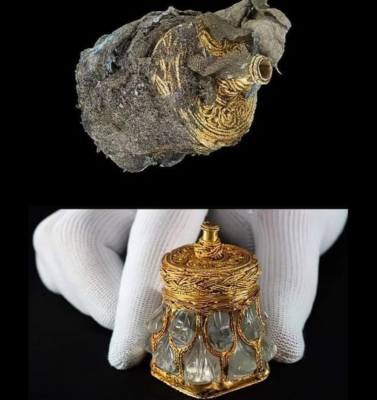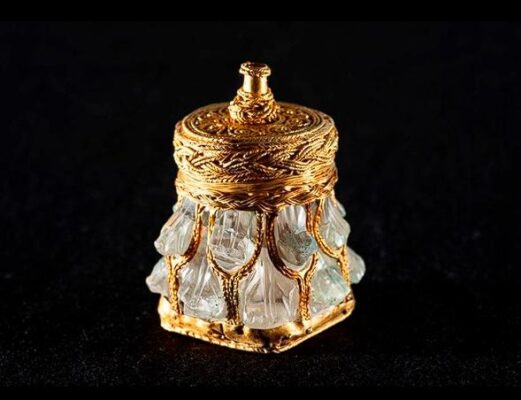Introduction
Among the many extraordinary artifacts discovered in the Galloway Hoard, a Roman rock crystal jar stands out as a remarkable testament to craftsmanship and historical significance. Unearthed in 2014 in western Scotland, this small yet intricate artifact has undergone meticulous restoration, shedding light on its origins, purpose, and importance in both Roman and Viking cultures.
The Discovery of the Galloway Hoard
The Unearthing of a Treasure Trove
The Galloway Hoard was discovered by a metal detectorist in a plowed field in Dumfries and Galloway, Scotland. This incredible find consists of over 100 artifacts, including gold and silver jewelry, textiles, and relics from various civilizations. The hoard, dating back to the late eighth or early ninth century, provides a rare glimpse into the material wealth and cultural exchanges of the Viking Age.
A Blend of Civilizations
One of the most fascinating aspects of the Galloway Hoard is its diverse origins. The collection includes items from Anglo-Saxon, Irish, and even Roman sources, demonstrating the extensive trade networks and complex interactions between different civilizations during the Viking period.

The Roman Rock Crystal Jar: A Closer Look
Exceptional Craftsmanship
The Roman rock crystal jar, measuring approximately 5 cm (2 inches) in height, is an exquisite example of ancient artistry. The jar itself is crafted from a single piece of transparent rock crystal, a material highly prized in antiquity for its clarity and beauty. It is encased in delicate gold filigree, intricately wrapped around its body, indicating the skill of master artisans.
Purpose and Function
Historians believe that this jar may have originally served as a container for perfume, oils, or a valuable potion. Such items were commonly used in royal anointing ceremonies or religious rituals, signifying their importance in both secular and sacred contexts. The presence of a silk-lined leather pouch further underscores the artifact’s significance, suggesting that it was a cherished possession, possibly belonging to a high-ranking individual or religious leader.
Historical Context and Cultural Significance
The Roman Influence
The craftsmanship of the rock crystal jar points to Roman origins, as the Romans were known for their advanced glass and gemstone carving techniques. Rock crystal objects were often associated with wealth, power, and spirituality, making them highly desirable commodities.
The Viking Connection
While the jar itself is of Roman origin, its discovery within a Viking hoard raises intriguing questions about its journey. Vikings were known for their extensive trade routes, raiding, and collecting valuable artifacts from different cultures. The inclusion of this jar in the Galloway Hoard suggests it was either acquired through trade, plunder, or as a diplomatic gift, illustrating the Vikings’ appreciation for fine craftsmanship and exotic goods.

The Restoration Process
Preserving an Ancient Artifact
Following its discovery, the Roman rock crystal jar underwent a meticulous restoration process to ensure its preservation. Experts carefully cleaned the delicate surface, stabilized the gold filigree, and conducted thorough examinations to determine its composition and history.
Technological Insights
Modern technology, including high-resolution imaging and material analysis, provided valuable insights into the artifact’s construction. Researchers were able to confirm the purity of the rock crystal and the intricate techniques used to create the gold wrapping, further highlighting the jar’s extraordinary craftsmanship.
What the Roman Rock Crystal Jar Reveals About the Past
Symbolism and Meaning
The presence of such a rare and luxurious item in the Galloway Hoard suggests that it held significant symbolic meaning. It may have represented power, divine connection, or prestige among those who owned it.
Trade and Cultural Exchange
The jar also highlights the interconnectedness of ancient civilizations. Its Roman origins, combined with its Viking-era discovery, provide evidence of the extensive trade networks and cross-cultural influences that shaped medieval Europe. This artifact serves as a tangible link between different peoples, illustrating the movement of luxury goods across vast distances.
Conclusion
The Roman rock crystal jar from the Galloway Hoard is a captivating artifact that bridges the gap between Roman craftsmanship and Viking-age treasure hoarding. Its exquisite design, historical significance, and the mystery surrounding its journey make it a fascinating subject of study. As restoration and research continue, this remarkable piece will undoubtedly reveal even more about the intricate connections between ancient civilizations. Whether as a symbol of power, a sacred relic, or a treasured possession, the jar remains a testament to the artistry and ingenuity of the past.

CÁC TIN KHÁC
Mary Walton: The Forgotten Inventor Who Helped Clean Up America’s Cities
Tomb of Queen Nefertari in the Valley of the Queens, Egypt
Discover the Hypostyle Hall of the Temple of Hathor at Dendera
Venus de Losange: Unveiling the Mystery of a 20,000-Year-Old Paleolithic Icon